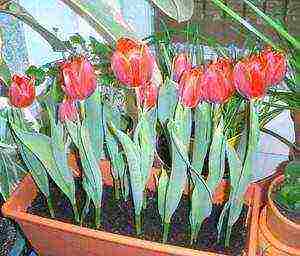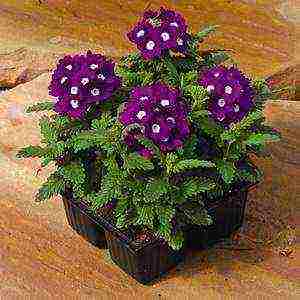Content
- 1 Growing at home
- 2 How to care for a palm tree at home?
- 3 Date palm pests and diseases
- 4 Possible growing problems
- 5 How to grow a date palm from seed?
- 6 How to care for a palm tree at home?
- 7 Growing conditions
- 8 Growing a date palm from a stone
- 9 Date palm from stone: care
- 10 Watering
- 11 Transfer
- 12 Reproduction
- 13 Pests
- 14 Diseases
- 15 Why does the date palm start to dry?
- 16 Why does the date palm turn yellow?
- 17 Why do the leaves of the date palm darken?
- 18 Date palm does not grow
- 19 Selection of seeds and their preparation for planting
- 20 Conditions for growing date palm
- 21 Stages of transplanting date palm from stone at home: from stone to palm
- 22 Date tree care rules
- 23 Conclusion
Do you want to create a uniquely beautiful exposition? Grow a tree plant. For those who have such a desire, a date palm from a stone at home is the best option.
Growing at home
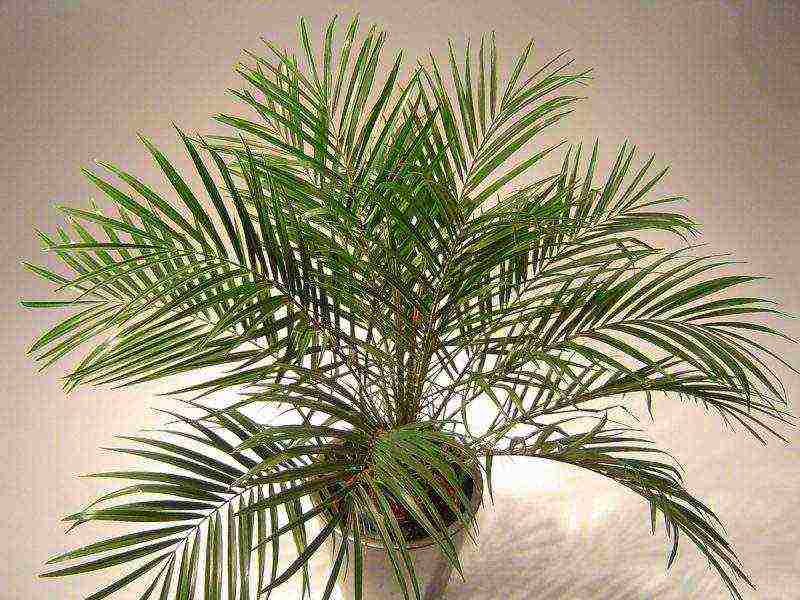
To grow a date palm, you have to be patient. It grows slowly and, unfortunately, will not bear fruit at home. For this, its height must be at least 15 m. But this is not necessary. Even without fruit, an attractive plant with huge fans of leaves will decorate any interior. This will require a lot of space and light.
How to germinate a date bone?
Any plant starts with a seed. The date palm is no exception. There is no need to look specifically for its seeds - you can buy dates at any grocery store. There is no point in planting date palm seeds that are not germinated. Most likely, they simply will not rise or the process will drag on for a very long time.
So, we germinate:
- choose bones from dates bought in the store;
- we inspect them for damage, traces of mold or insects, we reject all non-standard ones;
- soak in clean water for a day to remove the remnants of the pulp, changing it several times, the pulp contains substances that inhibit seed germination;
- we wash the bones;
- wake up the seed for 48 hours in a thermos with slightly warmed melt water with the addition of a few grains of humate;
- put in a container with a damp loose material: vermicult, hydrogel, crushed and sterilized sphagnum moss, placing all this in a plastic bag;
- for germination of seeds, a temperature of about 35 degrees is needed - a place near a heating radiator is ideal;
- germination lasts from 2 to 3 months, and all this time it is necessary to monitor the moisture content of the substrate and remove the condensation formed on the film.
As soon as the sharp little sprouts appeared, it was time to move the bones into the ground.
Ground requirement
The best soil for both young palms and grown plants is the palm substrate.
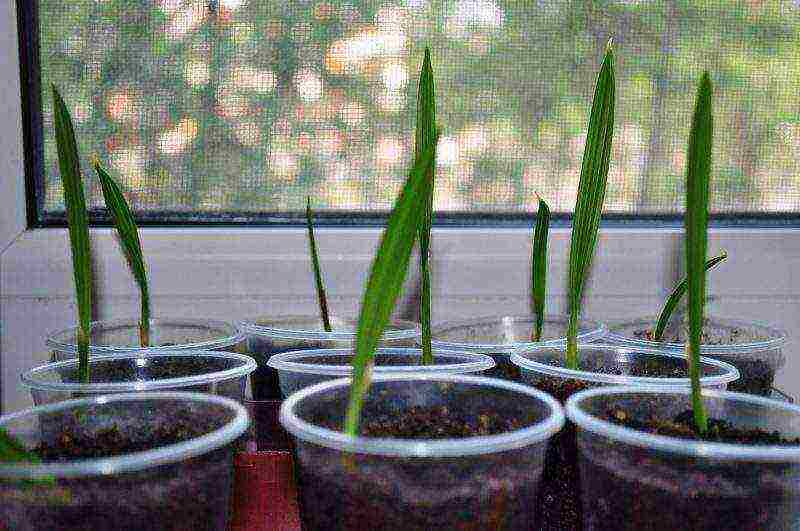
If it is not possible to purchase it, prepare the soil of the following composition:
- sod land;
- peat;
- sand.
All components are taken in equal parts. You can add a little steamed moss or hardwood sawdust for looseness. At this stage, a pot 10 or 12 cm high is enough for the plant.There should be drainage at the bottom of the pot.
Landing rules
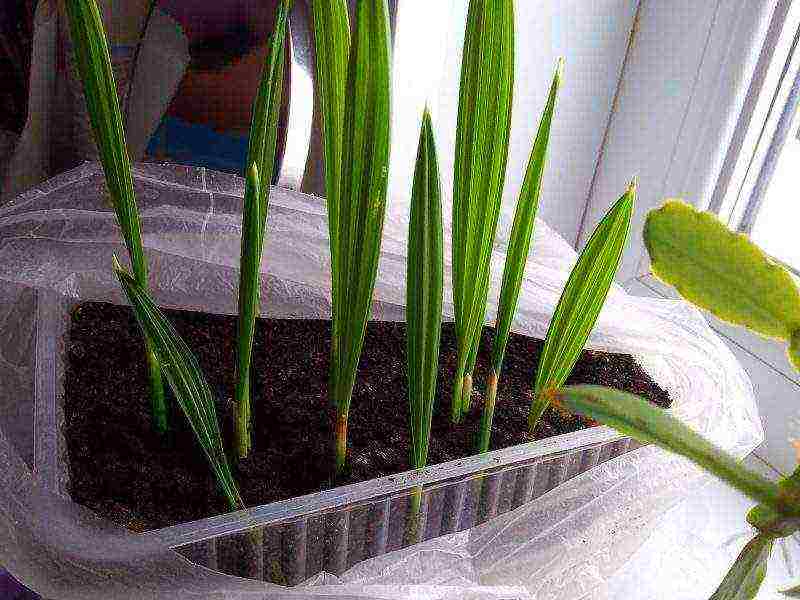
There is no consensus among flower growers here. Most believe that the bone should be stuck vertically so that there is a 1 cm layer of soil above it.But there is an opinion that seeds laid in pots horizontally with a seam down and covered with a layer of soil 2 cm thick will germinate better. hassle is not worth it. Their germination capacity is not very good, so it is easier to plant several seeds in two pots in different ways and see which one is more effective. You will have to be patient while waiting for the shoots. Germination can take up to 5 months. All this time, a plastic bag should be put on the pot, which should be removed for ventilation. The soil is sprayed from a spray bottle to maintain its moisture content. The pots should be kept at temperatures between 20 and 30 degrees. They do not need light at this time.
How to care for a palm tree at home?
To grow a date palm from a stone, it is not enough to plant it, you need to properly care for newly emerged seedlings and adult plants. This tree is very sensitive to any errors in care, to which it responds with poor health. Young, newly hatched sprouts especially need attention. They grow very quickly, which is not surprising - after all, this is a tree. Its vigor is much higher than that of herbaceous plants. Only after the opening of the first leaf does the growth rate slow down. The first leaves are completely unlike palm leaves, they are linear with clearly visible longitudinal grooves. Then they will split into segments that make up amazingly beautiful fans.
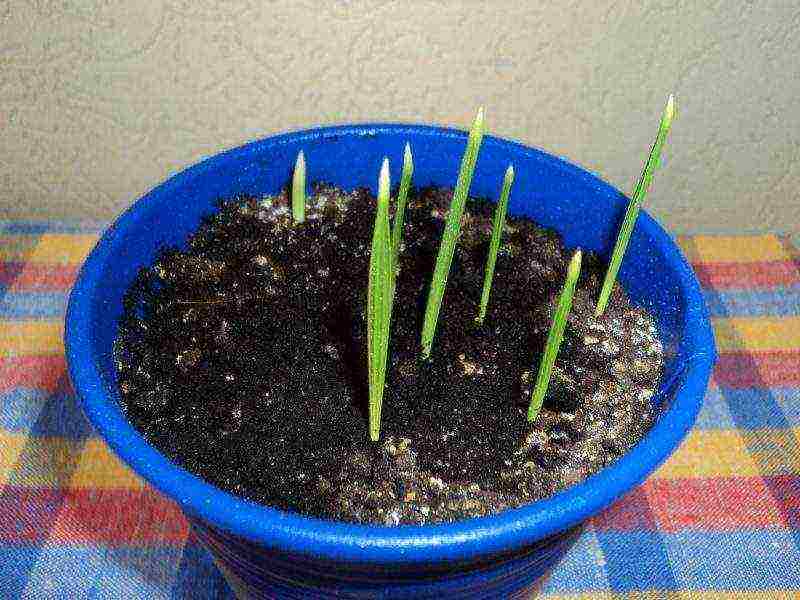
At the beginning of growth, the palm tree needs a lot of light, so the pots are placed on the lightest window. The air temperature for young plants should not drop below 20 degrees. In winter, you can insulate the window sill from the bottom so that the cold air does not lower the soil temperature in the pot.
If several plants have sprouted in the pot, each will need an individual container for growth.
Transplant soil needs the following composition:
- humus - 4 parts;
- peat - 1 part;
- turf and leafy land, sand - 2 parts each.
It is good to add crushed charcoal to the mixture. Transplanting into individual pots with a diameter of about 15 cm is carried out when the first sheet has a length of 15 cm. Drainage should consist of expanded clay with an admixture of charcoal. Its thickness is about 2 cm.
If possible, the palm tree should spend in the fresh air in summer. Such a "summer vacation" will benefit the tree.
The main conditions for keeping a date palm in a room:
- maximum illumination, but with diffused light; this tree in its homeland can withstand the scorching rays of the sun without damage to health, in the room they can cause burns on the leaves; even in winter, the daylight hours for a plant should not be less than 12 hours; it is extended by lighting with phytolamps.
For the symmetrical development of the crown, every 14 days the pot with the plant is turned 180 degrees.
- air humidity about 50%;
- air temperature in summer - from 20 to 25 degrees, in winter it is reduced to 16 degrees in order to slow down the metabolism in plant tissues in conditions of insufficient lighting;
- planting and transplanting into soil for date palms, which has a neutral or slightly acidic reaction;
- mandatory drainage;
- daily ventilation of the room;
- timely correct feeding and watering.
How to water properly?
The watering schedule and the amount of water directly depend on the season. In the summer they water it so that the earthy clod does not dry out - from 3 to 4 times a week. During the period of forced dormancy from watering to watering, the earthen lump should dry out slightly. It is enough to moisturize the palm 1-2 times a week. Overflow is harmful, therefore, excess water from the sump must be poured out half an hour after the soil has been moistened. Special attention is paid to the quality of irrigation water.Ideally, it should be thawed or clean rain, soft with a minimum amount of salt. The water temperature is about 33 degrees.
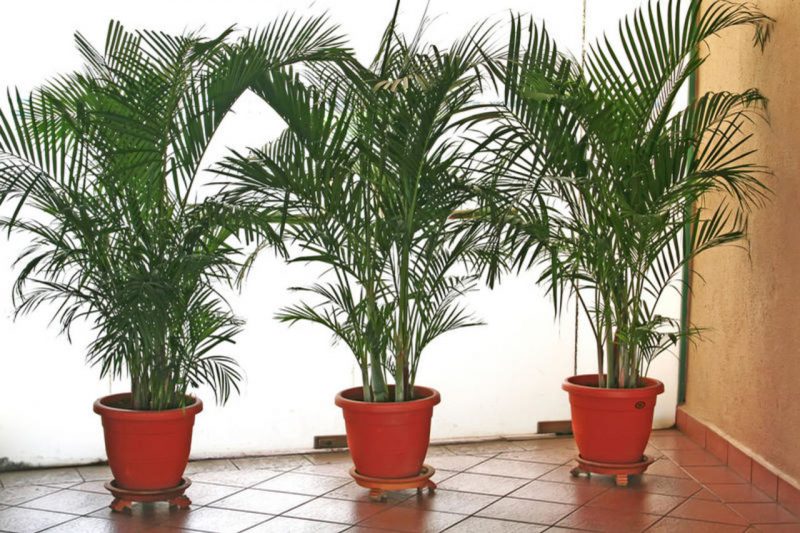
The plant responds well to spraying with warm soft water, especially in summer. He will also need sanitary procedures - wiping the leaves with a damp cloth, followed by drying with a dry cloth. Plants can be given a warm shower once a month, but the potted soil should be covered to prevent it from getting wet.
Top dressing and fertilization
In the season of active growth - in spring and summer, the tree is fed with complex fertilizer for palms every 14 days. In winter, the intensity of dressing is reduced by 2-3 times.
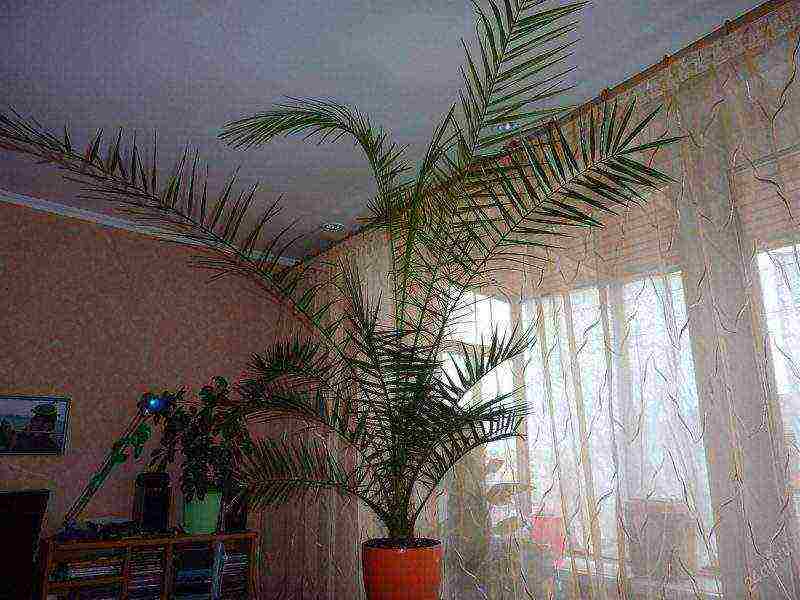
The palm tree responds very well to foliar dressing. They are made with the same fertilizer, but its concentration in the solution is reduced by 10 times. The frequency of dressings is from 3 to 1 times a month, depending on the strength of the plant's growth.
Plant transplant
The best time to transplant a palm tree is April. Young plants need this operation every year. After 5 years, the transplant is practiced every 2-3 years, and in plants older than 10 years, the top layer of the substrate is simply changed. The palm tree itself will tell you that it needs a new pot - roots will appear in the old one from the drainage hole.
They are thick at the palm, but fragile. She is extremely negative about their damage. For her, a transplant is a lot of stress, you need to do it carefully, preserving the earthen lump as much as possible.
The pot is chosen high, each transplant, its diameter is increased by 3-4 cm. Drainage must be placed on the bottom of the pot. The soil is prepared in the same way as for planting young plants.
The date palm is transplanted only by the transshipment method, without exposing the roots.
If this does happen, you will have to cut off some of the leaves in order to maintain a balance between the underground and aboveground parts. Even in not old plants, you can replace the top layer of the soil - there will be more nutrition for the palm tree. This procedure is carried out every six months.
Reproduction
The date palm reproduces by seeds. In some species, shoots may appear. These include the Robelen date.
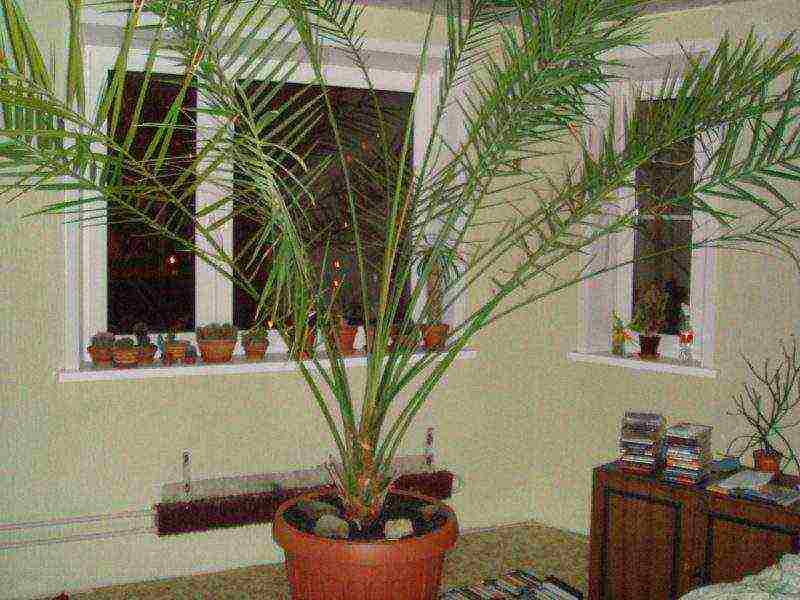
If the daughter plant has developed roots, it can be separated.
- With a sharp knife, cut off the baby as close to the trunk as possible without damaging it.
- We transplant the cut into the soil for palm trees, acting in the same way as when transplanting an adult plant.
- At first, you will have to put a plastic bag on a pot with a young palm tree so that it takes root better.
Do not forget to spray the young plant more often.
Date palm pests and diseases
A date palm that spends the summer outdoors may acquire a spider mite, scale insect, or mealybug. But even if the plant is constantly kept indoors, pests still appear. Insecticides, for example, Actellik, will help to cope with them. It is only advisable to process the plant with it in the open air. As a preventive measure, a monthly warm shower with washing the leaves with soapy water is good. But the soil in the pot must be protected from it.
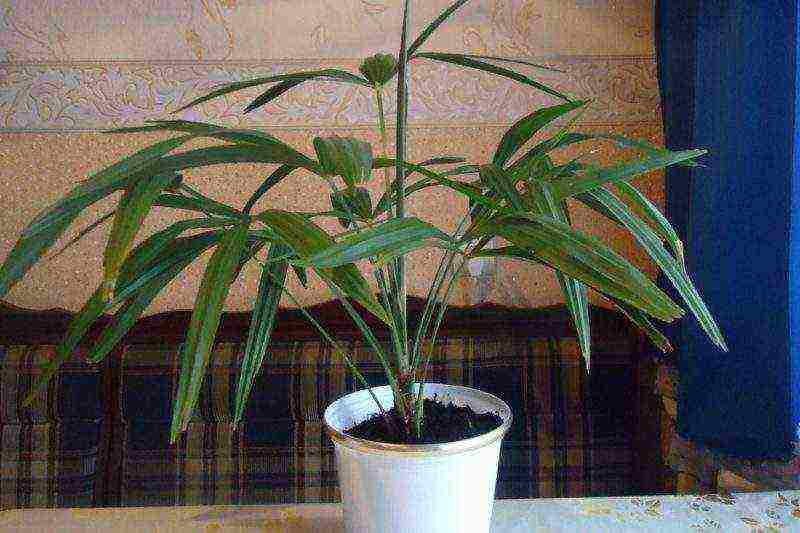
The main diseases of the palm are pink rot and mottling. Plants weakened by poor care usually get sick. Control measures - fungicides, but not containing copper: Mancozeb, Ridomil.
Possible growing problems
The palm tree is very sensitive to the observance of all care rules. When deviating from them, the leaves are the first to suffer.
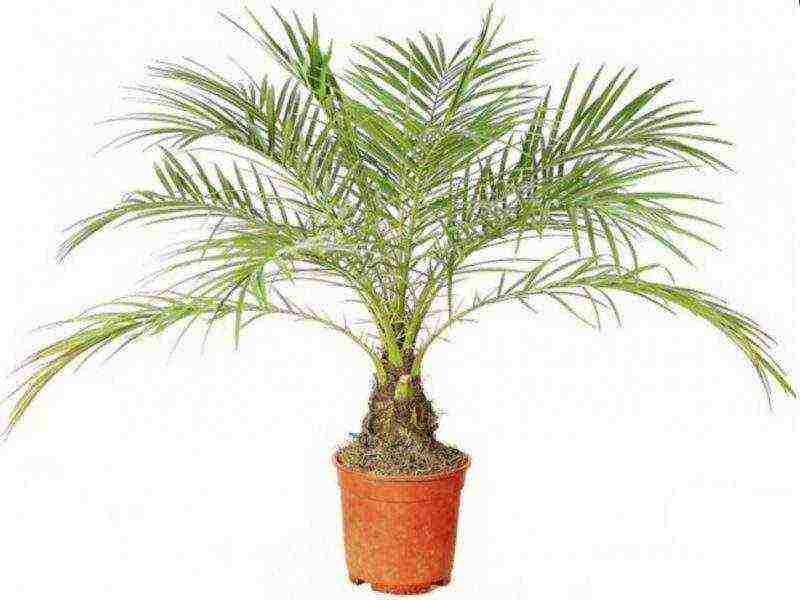
- The tips of the leaves dry out - the air is too dry, you need to spray the plants more often.
- Leaves turn yellow - lack of moisture, you need to water more often.
- Leaves darken - waterlogging, reduce the amount of watering.
- The date palm stops growing - it's too cold indoors. At temperatures below 16 degrees, the roots function poorly, practically not absorbing nutrients. Another reason may be the high acidity of the soil. It acidifies when watered with hard water. Such a plant will have to be transplanted.
In general, caring for an indoor giant is not so difficult.Palms are very responsive to care and will delight the grower with good growth and a healthy look.
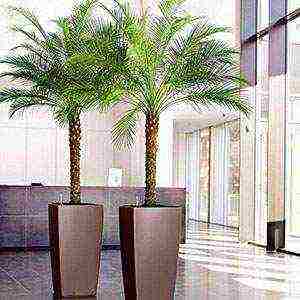 Looking at the oblong bones inside the dates loved by kids and adults, many indoor plant lovers wondered: "How does a real date palm grow from such a crumb, and what will happen if you plant a seed at home?"
Looking at the oblong bones inside the dates loved by kids and adults, many indoor plant lovers wondered: "How does a real date palm grow from such a crumb, and what will happen if you plant a seed at home?"
The sweet dates sold in stores are from the Phoenix dactylifera genus. In nature, a powerful tree grows to gigantic proportions, giving huge clusters of fruits famous all over the world.
For indoor cultivation, more miniature species adapted to indoor maintenance are offered. These palms can be seen and purchased at flower shops. If you want to independently start growing a date palm from a stone, there is a high probability of success.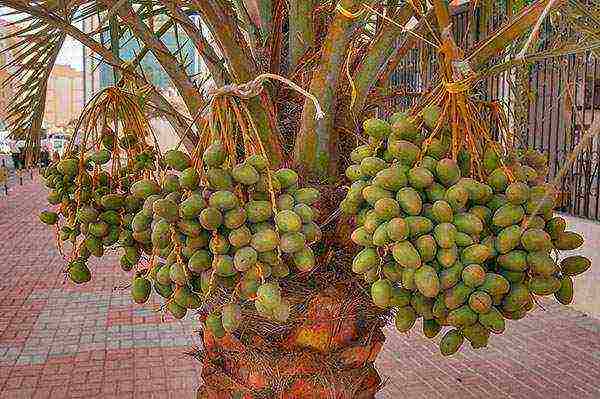
Of course, you won't be able to wait until the tree reaches its true height of 30 meters and gives the first harvest of dates. But watching the growth and development of an unusual plant will appeal to both parents and children.
How to grow a date palm from seed?
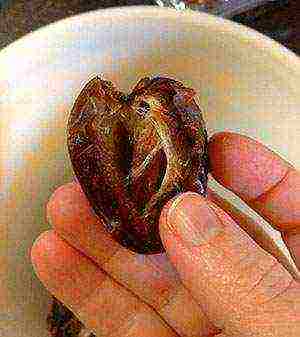 For planting, you will need seeds that have just been extracted from ripe fruits. Shop dates are fine. The main thing is that they are healthy, not damaged by insects or mold and do not have time to dry, otherwise the probability of getting seedlings is sharply reduced:
For planting, you will need seeds that have just been extracted from ripe fruits. Shop dates are fine. The main thing is that they are healthy, not damaged by insects or mold and do not have time to dry, otherwise the probability of getting seedlings is sharply reduced:
- Before growing a palm tree from a date seed, the seeds are immersed in clean warm water for 24–48 hours. During this time, the liquid is changed several times. The procedure will help free the bones from the remnants of the pulp, which will exclude mold from the seeds that have fallen into the ground, and will accelerate the emergence of sprouts.
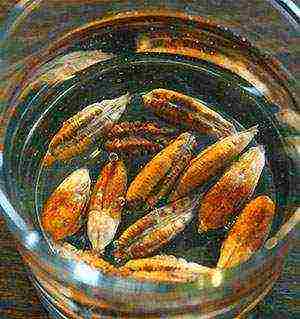
- Planting is carried out in a ready-made substrate for palm trees or a mixture of sand and peat. The soil is moderately moistened, and the container is placed in a warm place. In the next 2-3 weeks, caring for the palm tree at home consists of regular, but very careful watering and airing.
- The emerging date palm sprouts are extremely sensitive to waterlogging, therefore, when grown in a greenhouse, they are regularly ventilated and the resulting condensation is removed.
Before the seeds are submerged in the soil, it is sometimes advised to carefully scratch them to facilitate germination. It is much healthier and safer to germinate them in wet vermiculite. The container with seeds is placed in a warm place and it is observed that the substrate does not turn out to be completely dry. In this case, after 10-14 days, as soon as the grower notices the first roots, the seeds are transferred to the soil and the pots are placed in a warm place in a well-lit place.
 If the sprout has not appeared in due time, there is no need to despair. Perhaps the bone is dry before planting and it will take longer to "revive". Sometimes seedlings of the date palm were found even six months after the seeds were embedded in the ground.
If the sprout has not appeared in due time, there is no need to despair. Perhaps the bone is dry before planting and it will take longer to "revive". Sometimes seedlings of the date palm were found even six months after the seeds were embedded in the ground.
The date palm that has emerged from the stone is afraid of damage to the roots, so it is important to carry out all transplant manipulations very carefully and carefully. Otherwise, a small seedling takes an extremely long time to acclimatize or may die altogether.
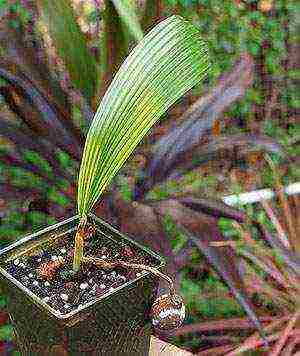 How to take care of the palm tree further at home? Unlike ordinary houseplants for a date palm, even the first pot needs a very impressive size. A seedling with a single, still closed "baby" leaf is transferred into containers of 0.3-0.5 liters. The next transplant is carried out until the moment when the long taproot of the plant penetrates into the drainage hole.
How to take care of the palm tree further at home? Unlike ordinary houseplants for a date palm, even the first pot needs a very impressive size. A seedling with a single, still closed "baby" leaf is transferred into containers of 0.3-0.5 liters. The next transplant is carried out until the moment when the long taproot of the plant penetrates into the drainage hole.
Saplings need a bright place where the plant will not be in the dark, but it will not be disturbed by the midday sun. Watering for date palm from seed and after germination should be scanty. Overmoistening threatens the development of rot and the death of an immature plant, but it is not worth overdrying the earthen lump either.
How to care for a palm tree at home?
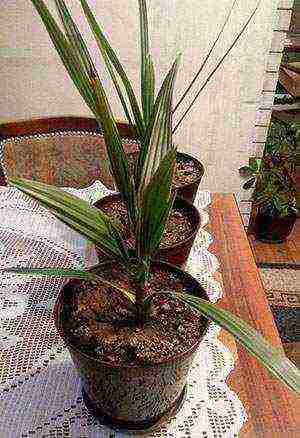 The date palm, like other tree crops, does not grow rapidly.But the plant reacts immediately to discomfort and insufficient care of the palm tree at home. This is especially true for young specimens.
The date palm, like other tree crops, does not grow rapidly.But the plant reacts immediately to discomfort and insufficient care of the palm tree at home. This is especially true for young specimens.
What conditions does a palm tree need to make the plant feel "at home" and respond well to care?
Whether it's a home-grown date palm or a plant brought from a flower shop, the culture needs to find a spot with the right lighting. In nature, large trees easily tolerate the scorching sun, but it is better not to subject a photophilous indoor palm tree to such tests. The optimal location is in the back of the room, facing the south, as well as on the east or west windows.
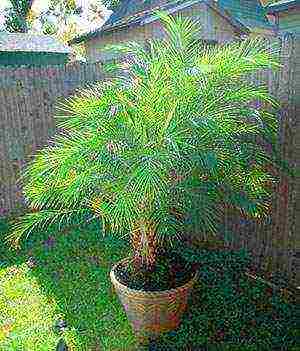 Since May, when the average daily temperature exceeds 12 ° C, the date palm is not threatened. Therefore, the plants are safely transferred to the open air under the protection of larger crops, to a loggia or balcony.
Since May, when the average daily temperature exceeds 12 ° C, the date palm is not threatened. Therefore, the plants are safely transferred to the open air under the protection of larger crops, to a loggia or balcony.
If the grower does not have the opportunity to take the palm tree out into the air, the plant develops well at normal room temperature. But in winter, the content in cooler air, warmed up to only 16-18 ° C, will be optimal. Cooling down to 12 ° C is considered critical for the date palm. In this case, growth stops, the palm stops feeding and may suffer from root rot if watering is not stopped in time.
The plant has no special requirements for the humidity of the ambient air. But in the hot season, as well as in winter, when the heating works in the room, regular home care of the palm tree includes spraying the crown and wiping the foliage with a damp cloth.
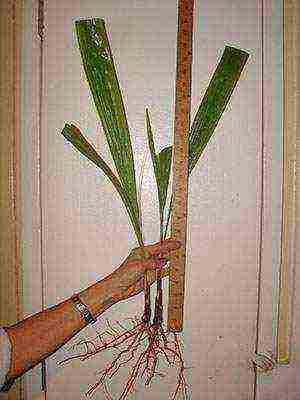 The plant does not tolerate stagnant water. Therefore, when leaving at home, the date palm is watered so that the soil does not dry out, but is not constantly wet. In summer, watering is carried out more often, in winter, the intervals between procedures are increased and are guided by the drying out of 2-3 cm of the surface layer of the substrate. If irrigation water penetrates from the pot into the pan, it is immediately removed, and the bottom of the container is wiped. Do not forget about the powerful drainage layer. The larger the date palm and the pot intended for it, the thicker the layer of expanded clay or brick chips at the bottom.
The plant does not tolerate stagnant water. Therefore, when leaving at home, the date palm is watered so that the soil does not dry out, but is not constantly wet. In summer, watering is carried out more often, in winter, the intervals between procedures are increased and are guided by the drying out of 2-3 cm of the surface layer of the substrate. If irrigation water penetrates from the pot into the pan, it is immediately removed, and the bottom of the container is wiped. Do not forget about the powerful drainage layer. The larger the date palm and the pot intended for it, the thicker the layer of expanded clay or brick chips at the bottom.
The date palm willingly accepts spring-summer feeding, for which liquid complex formulations are used for large decorative deciduous crops. If the palm tree is taken out into the garden for the summer, the plant can be fed with bird droppings at intervals of 7-10 days, using a granular form or infusion.
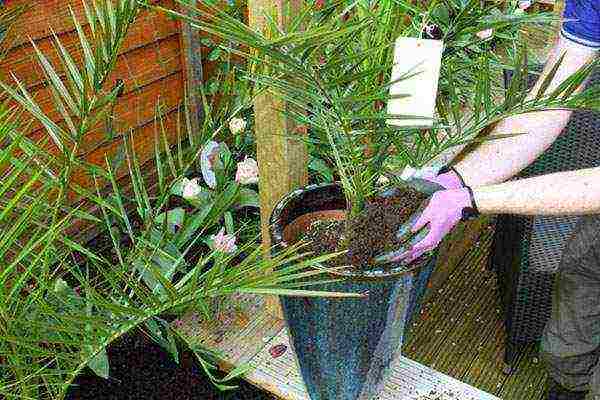 The frequency of replanting the date palm shown in the photo during home care depends on the age and size of the plant. Young seedlings are transferred to a larger pot about once a year, and adult specimens are in vain trying not to disturb. If transshipment is necessary, it is carried out, having previously shed an earthen lump well and trying not to damage the sensitive roots of the plant. The date palm is transplanted into ready-made soil offered by specialized stores.
The frequency of replanting the date palm shown in the photo during home care depends on the age and size of the plant. Young seedlings are transferred to a larger pot about once a year, and adult specimens are in vain trying not to disturb. If transshipment is necessary, it is carried out, having previously shed an earthen lump well and trying not to damage the sensitive roots of the plant. The date palm is transplanted into ready-made soil offered by specialized stores.
For arranging drainage, you can take brick chips or expanded clay according to the size of the drainage holes. If the roots of the date palm are still visible at the bottom of the pot, in the spring you can do without replacing the top layer of soil. The old substrate is carefully removed, and fresh nutrient soil is poured in its place. Then the palm is watered.
Experience of growing dates at home - video
The date palm is a plant of the palm family. There are about 20 species in total. It grows mainly in Africa and Eurasia. This plant has been known to mankind for over two thousand years. The first mention dates back to the 6th century BC - already at that time the date palm was grown in Mesopotamia (the territory of modern Iraq).
The tree belongs to the feathery type of palm. In nature, it can reach up to 30 m. The fruit of the date palm is a well-known and beloved delicacy by many, grown on an industrial scale.The juice is used to make sugar. However, indoor date palms have also gained popularity for a long time, interest in which has increased especially when it became known that they can be successfully grown from the stone of a date. But before growing a date from a stone, you need to find out the conditions for the growth of a plant in nature.
Growing conditions
In nature, it is a squat shrub or tree with feathery leaves, which are the main decorative merit of this plant. A date palm at home from a stone can only grow up to 2 meters, but even in this case, this houseplant will require significant space. Indoors, an adult tree is placed in spacious rooms with little furniture. But if it is grown from a stone, at home you can always make a place for a small pot, because the date will grow for a long time.
The date palm blooms in panicles of yellow flowers. But eating dates from this tree will not work: this exotic tree begins to bloom and bear fruit when it reaches 15 meters in height, which, of course, is simply impossible at home.
Growing a date palm from a stone
How to grow a date palm from seed? First of all, you should prepare the planting material for planting. For reliability, it is advisable to plant several seeds at once. Then prepare the soil for planting. Pits from fresh, dried or candied dates may be suitable - the most important thing is that the fruits are not subjected to early heat treatment. To obtain a soil suitable for seed germination, sand, raw sawdust and peat should be mixed in equal parts.
The bones are placed vertically in the ground, a layer of 1 cm of the same substrate is poured on top. The container or pot is placed in a warm enough place where the air temperature is more than 20-25 ºC. It is necessary to ensure that the soil is wet at all times, but not wet. It is recommended to keep it near a heat source. There is no need to wait for quick results: a bone in the ground can sit and swell until a sprout appears for 3 or even 6 months.
When the shoots appear, the container must be transferred to a bright light, but at the same time the seedlings must be protected from direct rays. The soil should be regularly moistened, and the seedlings should be sprayed with warm water. When the seedlings grow up to 10-15 cm, they must be planted in separate pots, the diameter of which is 15 cm. The soil should consist of 4 parts of humus, 1 part of peat soil and two parts of sand, leaf and sod land. You can also add 2 handfuls of charcoal to the mixture. Everything is thoroughly mixed before planting. Do not forget to lay a drainage layer on the bottom of the pot.
A date palm at home from a stone can give leaves only after 3 or even 5 years. The growing point of the plant is located at the top of the trunk, so it should not be cut off or attempted in any way to form the crown of the tree. You need to make sure that the new arrow of the leaf is turned into the shadow. You should also turn the pot from time to time so that the crown forms evenly.
Date palm from stone: care
Home tree maintenance is pretty simple. It must be kept in a bright, sunny and well-ventilated area. In summer, the air temperature can be any, and in winter - not lower than 12-13 ºC, but not more than 18 ºC.
In the heat, the leaves of the plant can dry out at the ends, so it is advisable to spray them several times a day or wipe them with a wet sponge, and once a week organize a shower for the plant.
In the summer, the palm tree should be fed weekly with mineral and organic fertilizers, in the fall, fertilized once every two weeks. In winter, it is enough to apply complex fertilizer once a month.
Watering
A date grown from a stone at home requires regular balanced watering with settled soft water.Balanced watering involves moistening the soil so that the plant has enough moisture, but nothing more. In order for excess moisture not to stagnate in the roots, you must remember to put a thick drainage layer in the pot when transplanting.
Transfer
Young plants that have not reached the age of five are transplanted annually, and those that are older - if necessary, because this tree does not like to be disturbed. When transplanting, they act very carefully so that the date palm root does not damage. It is best to use the transfer of the plant from the old container to a new one for this. The pot should be deep enough, since it has long roots, and each next flowerpot should be 3 or even 4 cm larger in diameter than the previous one. If the old container for the palm tree is still fit, but the soil has already lost the qualities useful for the plant, when transplanting, you should carefully remove the top layer of the old substrate and replace it with a fresh one. This is done every six months.
Reproduction
At home, the date palm is propagated only by seeds - bones.
Pests
Most often, a date palm at home from a stone, when the conditions of detention are violated, suffer from the following pests:
- spider mite;
- scabbards;
- mealybugs.
The best way to control pests is to correct grooming mistakes. The removal of insects and traces of their vital activity that destroy the tree is best done mechanically, by wiping the leaves with a soap and vodka solution. It is prepared as follows: take 15 g of any liquid soap, dishwashing detergent or grated solid soap dissolved in warm water and diluted in one liter of warm water. Next, 2 tbsp is added to the solution. spoons of vodka. If necessary, the processing of the leaves is repeated, you just need to remember to protect the soil from getting the solution into it. In case of severe pest infestation, one should resort to insecticide treatment, the best of which is Actellik.
Diseases
Date palm, grown at home from seed, is susceptible to the following diseases:
- spotting that disfigures the leaf plate;
- pink rot, affecting both the leaves and the stem, and causing them to rot.
Fortunately, only sick and weak plants are susceptible to infection with these diseases, therefore, the key to the health of the date is, first of all, compliance with the rules of care. If a date palm, grown from a stone at home, is sick, it is necessary to carry out a double treatment with a fungicide that contains methyl thiophanate and mankozeb.
Why does the date palm start to dry?
Sometimes the leaves of the plant begin to dry from the tips. This indicates that in the room where the tree is located, the air humidity is low (normal value is 50%). There are many ways to increase it to the required value. Spray and wash the leaves, otherwise the plant will lose its decorative appeal, and it will be a pity for wasted time and effort. Remember, a date palm, grown from a stone at home, dries up only from careless owners.
Why does the date palm turn yellow?
The reason is irregular spraying of plant leaves, insufficient watering.
Why do the leaves of the date palm darken?
If the soil in the pot, where the exotic date palm grows from the stone, undergoes constant waterlogging, the leaves gradually begin to darken, turn brown, the trunk of the plant becomes soft, and the smell of rot comes from the tree. In this case, stop watering, remove it from the pot and inspect the roots: if they are dark, soft and watery, the palm has already died. But if there are still living ones between the rotten roots, then you need to cut off the dead roots, sprinkle the cuts with crushed coal, and then transplant the plant into fresh soil.
Date palm does not grow
As already mentioned, the temperature in the room with the palm tree should not be lower than 12 ºC in winter. At other times of the year, at least 18-20 ºC, since root growth at 16-17 ºC stops, root activity slows down significantly, and the palm tree cannot absorb the necessary nutrients. This is what leads to the cessation of growth.
It can cause stagnation of growth and high acidity of the soil, which causes a lack of iron and manganese, therefore it is quite important to adhere to the correct temperature regime, as well as maintain soil acidity (pH below 7 units).
So, we looked at how to grow a date palm from a seed. There is nothing difficult in this, and the decorative qualities of the plant, of course, are worth all the effort spent. Wood can fit perfectly into a modern interior.
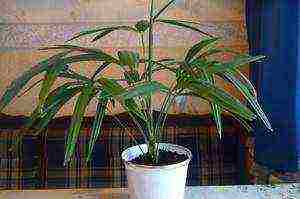 The date palm is a great opportunity to decorate any room, be it an ordinary apartment or office. There are several ways to implement this idea. The easiest way to get a plant is that it has the right size and appearance. However, growing a date palm on your own will bring much more joy to a person. Naturally, for this, you first have to get acquainted with the agricultural technology of work in our climate, which is an order of magnitude different from the tropics.
The date palm is a great opportunity to decorate any room, be it an ordinary apartment or office. There are several ways to implement this idea. The easiest way to get a plant is that it has the right size and appearance. However, growing a date palm on your own will bring much more joy to a person. Naturally, for this, you first have to get acquainted with the agricultural technology of work in our climate, which is an order of magnitude different from the tropics.
Selection of seeds and their preparation for planting
Regardless of the tree that you are going to grow at home, the first step is to prepare the planting material and provide it with favorable conditions for development. If you want to get a beautiful date palm from the seed, you need to decide on a variety that can grow indoors. To do this, you do not have to seek the help of specialists, since any dates that have not undergone heat treatment are suitable for this.
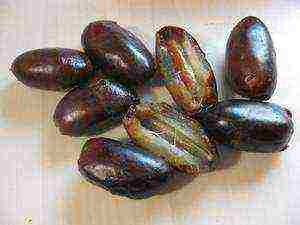 The most suitable the planting material is fresh dates... You don't need a photo for this, because if you don't have them, you can replace them with dry fruits, which can be found in any market.
The most suitable the planting material is fresh dates... You don't need a photo for this, because if you don't have them, you can replace them with dry fruits, which can be found in any market.
When choosing dried dates for growing an ornamental palm, it does not hurt to first ask the seller if they were cooked in sugar syrup. It is not worth buying fruits that have undergone a similar heat treatment, since the seeds taken from them will not germinate.
Preparation of planting material
When you have bones, you can start preparing them for planting:
- the first thing to do is separate the bone from the pulp, rinse it under warm water and let dry a little. It is recommended to use at least 6-10 seeds for cultivation. It is worth recalling that not all of them will germinate, some may die while still young seedlings;
-
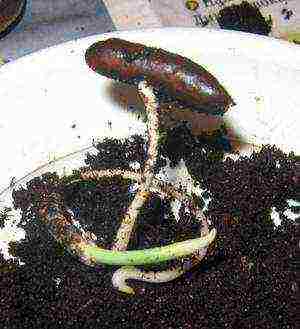 then clean bones are necessary hold for several days in warm water, a container with which is exposed to the sun. It is advisable to carry out such an operation in winter, since at this time the plant needs a small amount of light. Be sure to take care that the date pits do not start to rot or catch an infection while soaking. To do this, add fresh water once or twice a day;
then clean bones are necessary hold for several days in warm water, a container with which is exposed to the sun. It is advisable to carry out such an operation in winter, since at this time the plant needs a small amount of light. Be sure to take care that the date pits do not start to rot or catch an infection while soaking. To do this, add fresh water once or twice a day; - when the necessary time has passed for the seeds to settle, their pierce or begin to rub with sandpaper... Since the outer shell of the seeds is very hard, soaking is not always enough for them to open. Therefore, in some cases, it may be necessary to make an effort to break their integrity. But do not try to completely destroy the entire layer. You can limit yourself to one small area. Subsequently, the bones must again be placed in a jar of water and left for another 2-4 days to ripen.
You can offer another way by which you can speed up the ripening process. To do this, the prepared bones are placed in hot water heated to a temperature of 80 degrees, and kept in it for one to two minutes.A sign of seed readiness for planting will be their swelling.
Conditions for growing date palm
The photo of the tree should make it clear that it is not so easy to grow a beautiful date tree, since you need to be careful at every stage.
Even before you plant the seeds in the soil, you need to decide important questions:
- find a suitable room where the date palm will grow best;
- find a container of suitable sizes;
- prepare the soil.
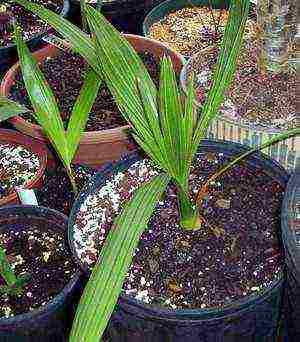 Given that the natural habitat of palm trees is the tropics, they can grow well with sufficient light and humidity. But this should not be taken as a recommendation that in the tub, you need to create conditions that resemble a swamp... For the normal development of date seedlings, it is necessary not only to carry out frequent watering, but also to provide direct sunlight for at least three to four hours a day. The most favorable conditions for the cultivation of the date palm can be created on the south side.
Given that the natural habitat of palm trees is the tropics, they can grow well with sufficient light and humidity. But this should not be taken as a recommendation that in the tub, you need to create conditions that resemble a swamp... For the normal development of date seedlings, it is necessary not only to carry out frequent watering, but also to provide direct sunlight for at least three to four hours a day. The most favorable conditions for the cultivation of the date palm can be created on the south side.
However, keep in mind that the date palm is a fairly tall tree that can grow up to 30 meters. But it is unlikely that it will grow as high in indoor conditions, usually its height is limited to 2-3 meters. Moreover, to reach such a mark, it will take at least 5 years. To avoid developmental delays palm tree it is necessary to provide the optimal amount of lighting throughout life... In the early years, it is allowed to grow young shoots in a pot on a windowsill. However, when the seedling matures, you will have to find a suitable place for it, well-lit by the sun.
Date palms can be grown in any suitable sized pots. But you need to remember that in the first years of life, they form a root, after which they form leaves. Growing a palm tree begins with planting seeds in a common garden bed, from which the seedlings are already planted in separate tubs.
The soil
To plant the seeds, you need soil of a suitable composition. The easiest way to buy it is at a flower shop. However, it should be a special soil where there is an indication "for palm trees". If you want to be sure of the quality of the planting soil, it is recommended to prepare it yourself.
A good basis for the soil will be raw sawdust, peat and sand, taken in equal amounts... Other types of soil cultivators, such as perlite, are also suitable for this. Before filling the pot with soil mixture, drainage is placed on the bottom. Subsequently, when the palm tree continues to mature, it must be replanted, each time preparing a new soil.
Stages of transplanting date palm from stone at home: from stone to palm
Proper seed preparation before planting is definitely an important exercise. However, this does not yet guarantee that strong beautiful plants will grow from them. If you do not follow the rules for care at one of the subsequent stages, then at any moment the tree can wither and die. This can be avoided if the following activities are carried out throughout the life of the plant:
-
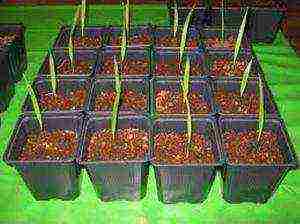 When the bones have passed all the necessary preparatory procedures, they planted vertically in a common spacious tubpre-filled with a special soil mixture. They should not be too deeply buried and tamped. You can limit yourself to sprinkling a small layer of earth on top.
When the bones have passed all the necessary preparatory procedures, they planted vertically in a common spacious tubpre-filled with a special soil mixture. They should not be too deeply buried and tamped. You can limit yourself to sprinkling a small layer of earth on top. - For seeds you can lay sphagnum moss or for them, you can arrange a greenhouse environment by placing a plastic or glass jar on top. Thanks to it, you can easily maintain a favorable temperature in the tub, and also prevent pests from reaching the bones.
- Until the bones of the date grow up, for them it is necessary to maintain a temperature regime of about 30 degrees and necessarily high humidity.
- Usually, seeds begin to germinate after one and a half to two months.But it so happens that after three months, seedlings do not appear. In this case, you need dig out the ground and find out what state it is in... It is possible that by this time the bone had time to sour or you used an unviable planting material.
- When young date palm seedlings begin to grow and reach a height of more than 10 cm, they can be transplanted into separate containers. For these purposes it is recommended use pots with a diameter of 9-12 cm... Moreover, in this case, the soil of a different composition is used. It is prepared from 4 parts of humus, 2 parts of sand, 1 part of peat and 2 parts of sod and leafy soil. As in the previous case, you need to take care of the availability of drainage and the creation of a normal watering regime.
Instances aged 5 years must be replanted every year. Subsequently, the transplant is carried out taking into account the size of the plants. This can be determined by protruding roots from the ground.
When the time comes for transplanting, it is imperative to shorten the felt layer formed by the roots. This will prepare the young palm tree for artificial growing conditions, thereby increasing its survival rate.
Home date palms: photos
Date tree care rules
If you want to enjoy the appearance of the date palm, then you will need to provide appropriate care. Considering that she is used to growing in the tropics, it will be useful for her:
- sunlight;
- moderate humidity;
- soft loose soil;
- periodic shower, which can be replaced by wiping the leaves with a damp cloth;
- high temperature conditions;
- spaciousness. A date palm can only be grown if there is a large enough free area so that light comes to it from all directions.
Other factors that are not included in this list are harmful to the palm tree. You can determine the deterioration of the tree by changing the leaves. They usually turn black. The most likely reason for this is a lack of sunlight or poor watering. It should also be borne in mind that the plant can infect a disease if there is a draft from the window in the room. For this reason, care must be taken to avoid sudden temperature fluctuations in the room.
Realizing that the plant began to feel worse, you need to immediately take urgent measures to correct the situation. Often it can be helped by increasing the humidity of the air, which can be done by spraying with ordinary water from a sprayer.
Conclusion
The date palm is interesting not only because it is a representative of the tropical climate, but also because of its original appearance. Even at a height of 2-3 meters, it can make the interior of any room attractive... Growing dates at home is not so difficult if you start paying attention to the plant already from the seed sowing stage. It is important to remember that the date palm will only grow well if it is provided with sufficient space. Therefore, at the moment when she becomes high enough, it is necessary to find an optimal place for her, where she will not feel constrained.

